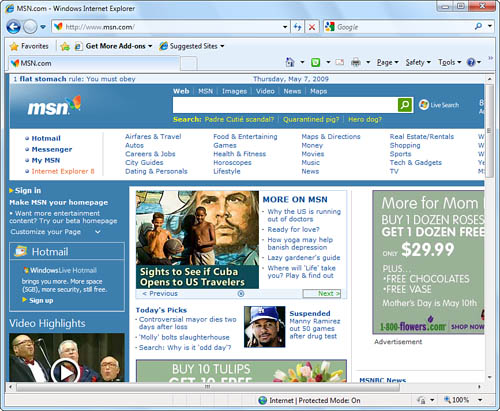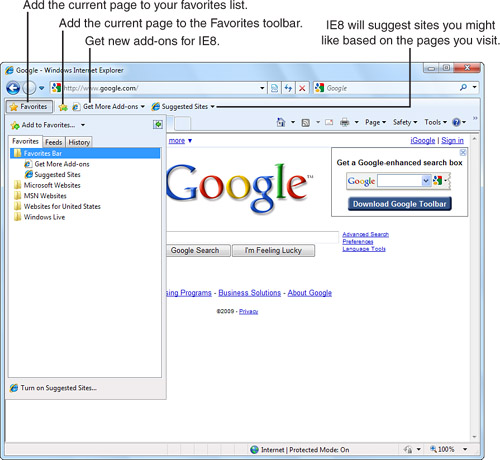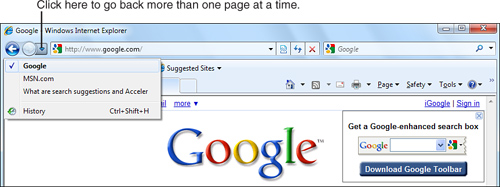Web browsers have become so ubiquitous that
we assume you are already comfortable with the basics of web browsing.
And because many Windows 7 elements such as Windows Explorer, the
Control Panel, and Network use the background code of IE7, you are
probably already familiar with the location of common toolbar buttons,
menus, and other screen elements.
Still,
IE8 does have some new features, so we provide an overview of how to
use some of them here. This overview will be especially useful if you
are switching from an even earlier version of Internet Explorer or
another web browser, such as Netscape Navigator.
You
can begin browsing the Internet by launching Internet Explorer from the
Start menu, or more conveniently from the Windows 7 taskbar.
If
you connect to the Internet via a dial-up connection, you might be
prompted to connect. When the connection is established, Internet
Explorer probably opens by default to the Windows Bing home page, as
shown in Figure 1,
so you can search the Web. Some PC manufacturers, such as Compaq,
customize IE before delivery so that you see their home page instead.

You
might find that IE8 occasionally fails to properly render a page or
appears incompatible with certain page content or site scripting. When
visiting a site built for IE7, the browser automatically offers you
Compatibility View. You’ll know it’s in effect because an informative
balloon tip appears along with an icon of a broken page that lights up
on the right side of the Address bar. To enable this workaround, click
the icon to activate Compatibility View; click again to disable it. IE8
remembers this mode for the pages you revisit so you won’t have to keep
engaging it, but you can also opt out of this feature for certain
pages. IE8’s Compatibility View only appears upon detection of an
incompatible site. |
|
Web pages change frequently, so the page you see will probably look different than Figure 1.
The general layout of the IE8 window might also be different from what
is shown here, although if you have performed a standard installation
of Windows 7 and have not done any customizations, it should look like
this.
Tip
Want
even more space to view web pages? Press F11 to change the view and
remove some screen elements to make more room for web documents. If you
don’t like what you see, press F11 again to toggle back. |
In
IE7, the Links bar provides users with one-click access to their
favorite sites; however, in IE8 this has undergone complete renovation
and is now the Favorites bar. Consider creating buttons on the
Favorites bar for the web pages you visit most frequently—page links,
RSS feeds, Web Slices, and even Microsoft Office documents. To see the
Favorites bar (enabled by default), right-click on an empty area of the
toolbar and click Favorites from the pop-up menu. The Favorites toolbar
appears, as shown in Figure 2. Before you customize the Favorites bar, keep these tips in mind:
The star icon just to the right of the Favorites button adds the current page to the Favorites toolbar.
The Get More Add-ons button opens a Web Slice where you can explore and obtain IE8 add-ons.
The
Suggested Sites Web Slice enables you to receive website suggestions
based on your browsing interests. Turn on Suggested Sites so that IE8
can better assist your web surfing habits.
You
can remove unwanted Favorites buttons by right-clicking them and
choosing Delete from the menu that appears. Alternatively, you can
click the Favorites button and delete Favorites entries in the
Favorites management window.
Make space
for more Favorites (and Internet Explorer’s toolbar area) by
right-clicking the Favorites button and uncheck Lock the Toolbars from
the menu that appears. Click the dotted handle on the left side of the
toolbar and drag it down to the Tabs level, then reenable the Lock the
Toolbars option.
To create more room,
reduce the length of your Address box and move it to share a “line”
with another toolbar. (The main toolbar, on the top line, is a good
place for the Address box.) Experiment with the placement of all
toolbars so that you have as much space as possible to view web pages.
The
easiest way to add a web page to the Favorites bar is to click the star
and arrow icon or drag the icon for the page from the Address box and
drop it onto the Favorites bar.

You
can navigate around the Internet by typing web addresses into the
Address box or by clicking hyperlinks on a page. The mouse pointer
changes from an arrow into a hand whenever it is located over a link.
Among the most useful features of the IE8 interface are the Back and
Forward buttons. When you click the Back button, you return to the
previously visited page. Clicking Forward moves you ahead once again.
(To move around even faster, Alt+left arrow and Alt+right arrow produce
the back and forward functions; if you have a new mouse, it might also
have special Back and Forward buttons on it.)
If
you receive a lot of “Page not available” errors, even on major
commercial sites, the most obvious suggestion is to check your Internet
connection. Your server might also be having a temporary problem, or
high Internet traffic might be preventing your access. Another thing to
consider is whether the page you are trying to visit is on a secure web
server. Click the Tools button in the toolbar, click Internet Options,
and then click the Advanced tab. Scroll down to the group of security
settings and see whether any of the encryption protocols supported by
IE are disabled. For example, if you are trying to visit a page that
uses PCT encryption but Use PCT 1.0 is disabled, that page will not
open. |
|
Notice
that next to both the Back and Forward buttons are downward-pointing
arrows. If you have been browsing several web pages, click the Recent
Pages button, which is the down-arrow button next to the Forward
button. A menu similar to that shown in Figure 3
should appear, showing a backward progression of the web pages you have
visited. Click a listing to move back several pages simultaneously
instead of one at a time.

Tip
Type
a term in the Address box and IE8 performs a search using your default
search engine selection. AutoComplete produces an immediate list of
hits drawing from your History and Favorites, all organized
categorically. Search terms aren’t isolated to word beginnings,
either—portions of page titles and URLs are also included. Highlight a
list entry and press Enter to visit the page. If
you want IE8 to include RSS feeds, click Tools, open the Internet
Options dialog box, and open the Content tab. Under the AutoComplete
heading, click the Settings button. Check the box next to Feeds, click
OK to accept the changes, and then click OK to close the Internet
Options dialog box. That’s it! |